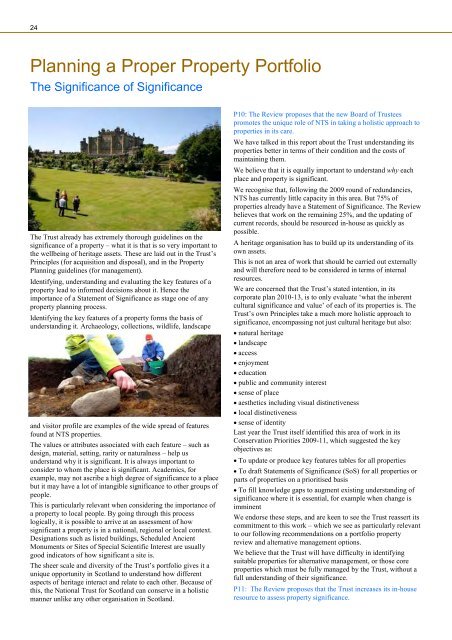NTS Report 4 Aug 2010 - National Trust for Scotland
NTS Report 4 Aug 2010 - National Trust for Scotland
NTS Report 4 Aug 2010 - National Trust for Scotland
You also want an ePaper? Increase the reach of your titles
YUMPU automatically turns print PDFs into web optimized ePapers that Google loves.
24<br />
Planning a Proper Property Portfolio<br />
The Significance of Significance<br />
The <strong>Trust</strong> already has extremely thorough guidelines on the<br />
significance of a property – what it is that is so very important to<br />
the wellbeing of heritage assets. These are laid out in the <strong>Trust</strong>’s<br />
Principles (<strong>for</strong> acquisition and disposal), and in the Property<br />
Planning guidelines (<strong>for</strong> management).<br />
Identifying, understanding and evaluating the key features of a<br />
property lead to in<strong>for</strong>med decisions about it. Hence the<br />
importance of a Statement of Significance as stage one of any<br />
property planning process.<br />
Identifying the key features of a property <strong>for</strong>ms the basis of<br />
understanding it. Archaeology, collections, wildlife, landscape<br />
and visitor profile are examples of the wide spread of features<br />
found at <strong>NTS</strong> properties.<br />
The values or attributes associated with each feature – such as<br />
design, material, setting, rarity or naturalness – help us<br />
understand why it is significant. It is always important to<br />
consider to whom the place is significant. Academics, <strong>for</strong><br />
example, may not ascribe a high degree of significance to a place<br />
but it may have a lot of intangible significance to other groups of<br />
people.<br />
This is particularly relevant when considering the importance of<br />
a property to local people. By going through this process<br />
logically, it is possible to arrive at an assessment of how<br />
significant a property is in a national, regional or local context.<br />
Designations such as listed buildings, Scheduled Ancient<br />
Monuments or Sites of Special Scientific Interest are usually<br />
good indicators of how significant a site is.<br />
The sheer scale and diversity of the <strong>Trust</strong>’s portfolio gives it a<br />
unique opportunity in <strong>Scotland</strong> to understand how different<br />
aspects of heritage interact and relate to each other. Because of<br />
this, the <strong>National</strong> <strong>Trust</strong> <strong>for</strong> <strong>Scotland</strong> can conserve in a holistic<br />
manner unlike any other organisation in <strong>Scotland</strong>.<br />
P10: The Review proposes that the new Board of <strong>Trust</strong>ees<br />
promotes the unique role of <strong>NTS</strong> in taking a holistic approach to<br />
properties in its care.<br />
We have talked in this report about the <strong>Trust</strong> understanding its<br />
properties better in terms of their condition and the costs of<br />
maintaining them.<br />
We believe that it is equally important to understand why each<br />
place and property is significant.<br />
We recognise that, following the 2009 round of redundancies,<br />
<strong>NTS</strong> has currently little capacity in this area. But 75% of<br />
properties already have a Statement of Significance. The Review<br />
believes that work on the remaining 25%, and the updating of<br />
current records, should be resourced in-house as quickly as<br />
possible.<br />
A heritage organisation has to build up its understanding of its<br />
own assets.<br />
This is not an area of work that should be carried out externally<br />
and will there<strong>for</strong>e need to be considered in terms of internal<br />
resources.<br />
We are concerned that the <strong>Trust</strong>’s stated intention, in its<br />
corporate plan <strong>2010</strong>-13, is to only evaluate ‘what the inherent<br />
cultural significance and value’ of each of its properties is. The<br />
<strong>Trust</strong>’s own Principles take a much more holistic approach to<br />
significance, encompassing not just cultural heritage but also:<br />
• natural heritage<br />
• landscape<br />
• access<br />
• enjoyment<br />
• education<br />
• public and community interest<br />
• sense of place<br />
• aesthetics including visual distinctiveness<br />
• local distinctiveness<br />
• sense of identity<br />
Last year the <strong>Trust</strong> itself identified this area of work in its<br />
Conservation Priorities 2009-11, which suggested the key<br />
objectives as:<br />
• To update or produce key features tables <strong>for</strong> all properties<br />
• To draft Statements of Significance (SoS) <strong>for</strong> all properties or<br />
parts of properties on a prioritised basis<br />
• To fill knowledge gaps to augment existing understanding of<br />
significance where it is essential, <strong>for</strong> example when change is<br />
imminent<br />
We endorse these steps, and are keen to see the <strong>Trust</strong> reassert its<br />
commitment to this work – which we see as particularly relevant<br />
to our following recommendations on a portfolio property<br />
review and alternative management options.<br />
We believe that the <strong>Trust</strong> will have difficulty in identifying<br />
suitable properties <strong>for</strong> alternative management, or those core<br />
properties which must be fully managed by the <strong>Trust</strong>, without a<br />
full understanding of their significance.<br />
P11: The Review proposes that the <strong>Trust</strong> increases its in-house<br />
resource to assess property significance.













![Elgin Cathedral Wedding Brochure [pdf, 544kb] - Historic Scotland](https://img.yumpu.com/22301571/1/190x151/elgin-cathedral-wedding-brochure-pdf-544kb-historic-scotland.jpg?quality=85)



